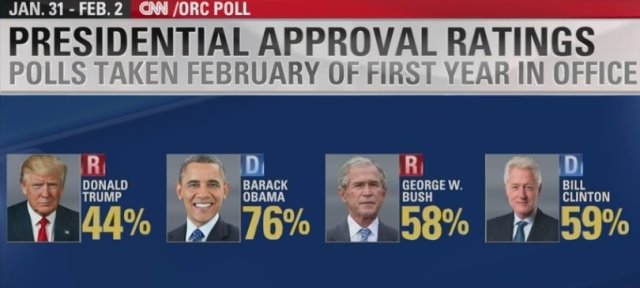President Trump is encouraging his 24 million Twitter followers to ignore accurate polls.
On Monday he tweeted — inaccurately — that “Any negative polls are fake news, just like the CNN, ABC, NBC polls in the election.”
Professional polling is scientific, not political, in nature. Polls by TV networks during the election were not “fake news.” In fact, most national polls were not far off the mark. The polls correctly showed Hillary Clinton winning the popular vote by a relatively small margin.
But that’s about the past. Trump’s tweet said more about the future. He was taking his long-standing poll denialism to its illogical conclusion, inviting his supporters to dismiss unpleasant data.
Trump specifically objected to polls that showed opposition to his administration’s temporary ban on travel from seven Muslim-majority countries.
“Sorry,” he wrote, “people want border security and extreme vetting.”
If by “people” Trump only means the Americans who voted for him, then that’s true. But the American public as a whole is starkly divided over the travel ban and other security measures.
Trump’s tweet seemed to be motivated by a Monday morning segment on CNN’s “New Day.” (The president frequently watches cable news in the morning.)
At 6:31 a.m. ET, CNN political director David Chalian showed CNN/ORC’s latest poll results, starting with 44% approval and 53% disapproval of Trump’s job performance.
Then he said, “What about that travel ban policy? How’s the country reacting to that? A majority are opposed. Slim majority. 53% of Americans oppose the travel ban, 47% in favor.”
The poll is a scientific sample of the American population at large.
Trump’s tweet provoked widespread criticism on Monday morning. “This is bizarre behavior. Something is not right,” Joaquin Castro, a Democratic congressman from Texas, responded.
Another vocal Trump critic, the activist Deray McKesson, tweeted, “‘Negative news = fake news’ is the beginning of tyranny.”
It came on the same morning that one of Trump’s friends, Newsmax CEO Chris Ruddy, was quoted in The New York Times saying, “I think, in his mind, the success of this is going to be the poll numbers.”
Throughout his adult life, Trump has cared deeply about various measures of his popularity, including magazine cover appearances, television ratings and rally crowd sizes.
But he is starting his presidency with historically low approval ratings and widespread opposition to some of his administration’s policies.
That’s why some observers have expected Trump to try to discredit approval rating polls.
On the campaign trail, Trump bragged about polls that were favorable for him, sometimes reading the data aloud during rallies. When the polls turned sour, he made unfounded claims about “crooked polls.”
In mid-January, shortly before taking office, Trump resumed his poll denialism.
“The same people who did the phony election polls, and were so wrong, are now doing approval rating polls. They are rigged just like before,” he wrote.
The polls are not rigged. While imperfect to be sure, polling is a science, and experts work hard to reflect the country’s views as accurately as possible.
Some pre-election polls were far off the mark, especially in swing states, for reasons that are now being studied by experts. These state polls caused many analysts to anticipate a Clinton victory on election night. But the national polls were by and large accurate.
“The polls that had Clinton winning the popular vote were accurate,” CNN’s Jake Tapper tweeted in response to Trump on Monday.
At last Friday’s White House briefing, press secretary Sean Spicer was asked about Trump’s low approval ratings. He responded with a somewhat sunnier poll from Rasmussen.
“I think there’s also a Rasmussen poll that showed he had a 51% approval rating,” Spicer said.
In fact, Rasmussen showed Trump at 54% approval, but the numbers are not exactly comparable to the other, lower approval polls. Why? Because Rasmussen surveyed a subset of people it defines as “likely voters” in elections. Most approval polls seek a sample of all adults, not just “likely voters,” in order to ascertain the views of the entire population.
Spicer, on Friday, did not decry the polling data as “fake news,” but instead predicted it would improve.
“The president understands this is a marathon, and not a sprint,” Spicer said. “And as he continues to get people back to work, protect this country, I think the poll numbers will act in accord.”
By dismissing negative poll numbers as “fake news,” Trump seems to be contradicting his press secretary again.



